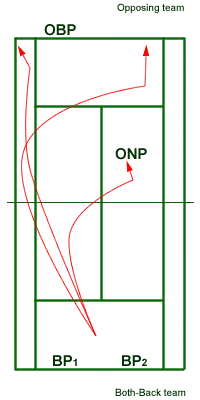This is mostly used as a defensive tactic. Or, the players are just not comfortable playing at the net (e.g. singles-oriented players who developed very dependable/comfortable baseline game, etc.).

Most of the common uses for the BB strategy are:
– The back team is receiving serve from a powerful opposing server.
This frequently results in floating returns that can be exploited by the opposing net player. In this case, it is wise to have the receiver’s partner start on the baseline and then move up together once the return has been made successfully. This takes the pressure off of the receiver and also gives the serving team a different view of the court.
– The back team is serving but the serve is being attacked by the receiver especially if it is a weak and slow second serve.
Starting the point with the server’s partner on the baseline avoids the receiver’s opportunity to blast the return at the net player. The back team should find ways to advance toward the net as soon as possible.
– The team has not developed strong, consistent volleys and players are timid with overheads.
In this situation, it is okay to stand back on the baseline and play defense by using groundstrokes.
The probability of hitting winners from this formation is slim – lobs, drop-shots, and groundstrokes short at the net players’ feet are the main options for the back players.
Positioning:
The back players should stand on the baseline or just inside the baseline when playing in BB formation. In this way, they will be able to cover and get to the short, angled shots and will have time to defend against deep balls.
The players should avoid leaving too much room between them; ideally, they should stand so that their arm and racquet extended toward each other should touch (no ball goes between them). Just like the both-up formation, the partners should try to keep together – if one of them chases a wide ball, the other one moves into that particular direction too – imagine there is a string attached to the players and it pulls them every time they move, thus keeping the distance between players consistent.
Standing on or just inside the baseline, the players should expect to take a lot of balls on the rise, or even half volleys. In order to do so, a low stance and short (or no) backswing is necessary. They should not back up to wait for the balls to come down – that gives the opposing players time to crowd the net and take advantage of the longer trajectory of the incoming ball and eventually finish the point with a winning volley.
How to be successful playing in the Both-Back formation:
Since the BB strategy is mostly a defense situation, the players will rely on consistent groundstrokes. They should use heavy topspin shots to keep the balls down to the net players’ feet, lob over the net player, or if one of the back players has the chance to hit the ball in the gap created by the opposing up-and-back opponents.
– Against the both-up formation, the back players should use lobs often. Also, topspin-driven low between the two up players can generate short mid-court returns that can set up the back players for an aggressive attack.
– Against the one-up-one-back formation, the both-back team should lob the net player or keep the ball deep to the opposing back player.
Very important for the back players is to use lobs often since this tactic will keep the opposing net players further back thus giving them the other option to hit down at the net players’ feet.
Communication is very important also, especially when the incoming ball is down the center. This is when the baseline players can get confused and invite/expect each other to take the ball.
It’s essential that, if communication fails, both players go for the ball and whoever gets there first, hit it. They better clash the racquets in an attempt to get to the ball than let it go between them.